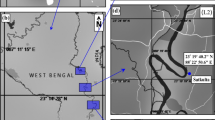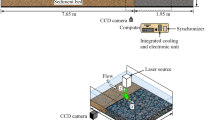Abstract
The present study examines the turbulent flow characteristics in the vicinity of the leading edge of a vertical retaining wall structure embedded in a gravel bed. Conditions before and during the initial stages of local scour development were considered. To that end, three laboratory experiments were carried out: one with fixed boundaries as a reference case, a second one with an erodible bed, but immobile channel bank, and a third one characterized by an erodible channel bed and bank. Instantaneous and time-averaged flow features, and turbulence statistics associated with the three-component velocity fields, obtained with a stereoscopic particle image velocimetry system, were analyzed. Water surface examination determined that channel bank erosion alters flow behavior upstream of the retaining wall. This change is manifested through more frequent formation of eddies near the top corner of the junction between the upstream face of the protrusion and the channel bank. Time-averaged and instantaneous velocity vector fields demonstrate the presence of two counter-rotating vortices in the experiments with the fixed channel bank, one located near the junction of retaining wall and the channel bed and one away from it generated as a result of a strong downflow. The latter motion represents a section of a horseshoe vortex. During the channel bank erosion, however, these vortices are not as significant and persistent. The results also indicate that the coherency and magnitude of the streamwise vorticity field diminish as a result of scour. However, it was confirmed that local turbulent kinetic energy and shear stresses increase in the presence of scour due to enhanced local flow separation.





















Similar content being viewed by others
References
Adrian RJ, Westerweel J (2011) Particle image velocimetry. Cambridge University Press, Cambridge
Apsilidis N, Diplas P, Dancey CL, Bouratsis P (2015) Time-resolved flow dynamics and reynolds number effects at a wall-cylinder junction. J Fluid Mech 776:475–511
Apsilidis N, Diplas P, Dancey CL, Bouratsis P (2016) Effects of wall roughness on turbulent junction flow characteristics. Exp Fluids 57:12
Benchikh Le Hocine AE, Lacey RWJ, Poncet S (2018) Turbulent fow over a D-section bluf body: a numerical benchmark. Environ Fluid Mech 19:435–456
Bressan F, Ballio F, Armenio V (2011) Turbulence around a scoured bridge abutment. J Turbul 12:N3
Celik AO, Diplas P, Dancey CL (2013) Instantaneous turbulent forces and impulse on a rough bed: implications for initiation of bed material movement. Water Resour Res 49:2213–2227
Chaudhry MH (2007) Open-channel flow. Springer, Berlin
Devenport WJ, Simpson RL (1990) Time-dependent and time-averaged turbulence structure near the nose of a wing-body junction. J Fluid Mech 210:23–55
Dey S, Barbhuiya A (2005) Flow field at a vertical-wall abutment. J Hydraul Eng 131(12):1126–1135
Dey S, Raikar RV (2005) Scour in long contractions. J Hydraul Eng 131(12):1036–1049
Dey S, Raikar RV (2007) Characteristics of horseshoe vortex in developing scour holes at piers. J Hydraul Eng 133:399–413
Dong S, Karniadakis GE, Ekmekci A, Rockwell D (2006) A combined direct numerical simulation-particle image velocimetry study of the turbulent near wake. J Fluid Mech 569:185–207
Duan J, He L, Fu X, Wang Q (2009) Mean flow and turbulence around experimental spur dike. Adv Water Resour 32(12):1717–1725
Fishman G (2018) The structure of a perturbed vortex and its interaction with a wing. Doctoral Dissertation, Lehigh University, Pennsylvania, USA. https://preserve.lehigh.edu/etd/4231
Jeon J, Lee JY, Kang S (2018) Experimental investigation of three-dimensional flow structure and turbulent flow mechanisms around a nonsubmerged spur dike with a low length-to-depth ratio. Water Resour Res 54(5):3530–3556
Karami H, Hosseinjanzadeh H, Hosseini K, Ardeshir A (2018) Scour and three-dimensional flow field measurement around short vertical-wall abutment protected by collar. KSCE J Civ Eng 22(1):141–152
Khosronejad A, Kozarek JL, Diplas P, Hill C, Jha R, Chatanantavet P, Heydari N, Sotiropoulos F (2018) Simulation-based optimization of in-stream structures design: rock vanes. Environ Fluid Mech 18(3):695–738
Khosronejad A, Diplas P, Angelidis D, Zhang Z, Heydari N, Sotiropoulos F (2019) Scour depth prediction at the base of longitudinal walls: a combined experimental, numerical, and field study. Environ Fluid Mech. https://doi.org/10.1007/s10652-019-09704-x
Kirkil G, Constantinescu G (2010) Flow and turbulence structure around an in—stream rectangular cylinder with scour hole. Water Resour Res 46:1–20
Koken M, Constantinescu G (2008a) An investigation of the flow and scour mechanisms around isolated spur dikes in a shallow open channel: 1. Conditions corresponding to the initiation of the erosion and deposition process. Water Resour Res 44(8):W08406
Koken M, Constantinescu G (2008b) An investigation of the flow and scour mechanisms around isolated spur dikes in a shallow open channel: 2. Conditions corresponding to the final stages of the erosion and deposition process. Water Resour Res 44(8):W08407
Lawson NJ, Wu J (1997) Three-dimensional particle image velocimetry: experimental error analysis of a digital angular stereoscopic system. Meas Sci Technol 8(12):1455–1464
Longo S, Liang D, Chiapponi L, Jiménez LA (2012) Turbulent flow structure in experimental laboratory wind-generated gravity waves. Coast Eng 64:1–15
Longo S, Chiapponi L, Clavero M (2014) Experimental analysis of the coherent structures and turbulence past a hydrofoil in stalling condition beneath a water-air interface. Eur J Mech B/Fluids 43:172–182
Melville BW, Raudkivi AJ (1977) Flow characteristics in local scour at bridge piers. J Hydraul Res 15:373–380
Molinas A, Kheireldin K, Wu B (1998) Shear stress around vertical wall abutments. J Hydraul Eng 124(8):822–830
Murakami S, Mochida A (1995) On turbulent vortex shedding flow past 2d square cylinder predicted by cfd. J Wind Eng Ind Aerodyn 54–55(3):191–211
Okajima A (1982) Strouhal numbers of rectangular cylinders. J Fluid Mech 123:379–398
Paik J, Sotiropoulos F (2005) Coherent structure dynamics upstream of a long rectangular block at the side of a large aspect ratio channel. Phys Fluids 17(11):115104
Petti M, Longo S (2001) Turbulence experiments in the swash zone. Coast Eng 43(1):1–24
Pierce FJ, Shin J (1992) The development of a turbulent junction vortex system. Journal of Fluids Engineering 144:559–565
Raffel M, Willert CE, Scarano F, Kähler CJ, Wereley ST, Kompenhans J (2018) Particle image velocimetry: a practical guide. Springer, Berlin
Rajaratnam N, Nwachukwu BA (1983) Flow near groin-like structures. J Hydraul Eng 109(3):463–480
Rashidi M, Hetsroni G, Banerjee S (1990) Particle-turbulence interaction in a boundary layer. Int J Multiphase Flow 16:935–949
Shirole AM, Holt R (1991) Planning for a comprehensive bridge safety assurance program. In: Proceedings of Bridge engineering conference, transportation research record, Denver,USA, vol 1, p 137
Unger J, Hager WH (2007) Down-flow and horseshoe vortex characteristics of sediment embedded bridge piers. Exp Fluids 42:1–19
Acknowledgements
The support of the National Cooperative Highway Research Program [Grant NCHRP-HR 24–36] for this study is gratefully acknowledged.
Author information
Authors and Affiliations
Corresponding author
Additional information
Publisher's Note
Springer Nature remains neutral with regard to jurisdictional claims in published maps and institutional affiliations.
Rights and permissions
About this article
Cite this article
Heydari, N., Diplas, P. Flow dynamics in the vicinity of a gravel embedded vertical retaining wall: conditions corresponding to the initial stages of local erosion. Environ Fluid Mech 20, 203–225 (2020). https://doi.org/10.1007/s10652-019-09715-8
Received:
Accepted:
Published:
Issue Date:
DOI: https://doi.org/10.1007/s10652-019-09715-8




